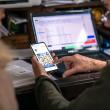You can do a lot on the internet, but you might be unsure where to start. If you're new to using it, there are a few things you should know to set yourself up for a good online experience.
Using the internet at home
If you don’t already have internet at home, you may want to get broadband. This is a high-speed internet connection you can set up and use at home. You can then set up a wireless network (WiFi) to connect laptops, tablets, smartphones and other devices to the internet without using cables.
Our webpage Smart technology for later life has more information on choosing a provider and setting up your internet connection.
To access the internet, you’ll need to connect your device to your WiFi network. There are a few simple steps to take:
- Make sure the WiFi connection for your device is turned on. Go to the ‘Settings’ on your device to check this.
- Once the WiFi for your device is turned on, you should be given a list of WiFi networks you can connect to.
- Select the WiFi network you want to connect to. If you’re connecting to your own WiFi network, the name of the network is usually on a sticker on your WiFi router.
- Enter the password for the network. If you’re connecting to your own WiFi network, this will be in the same place as the network’s name.
Once you’re connected to the WiFi network, your device should automatically connect whenever you're in the house.
When using a public WiFi connection, it will be less secure than using your own password-protected WiFi. Try to avoid tasks that need sensitive information, such as internet banking and online shopping.
Browsing the internet
To access the internet, you’ll need to use a web browser. This application helps you find and visit websites on your device.
The most common ones include:
- Google Chrome
- Safari (if you’re using an Apple device). This software is built into all Mac devices, so you don't have to download it
- Microsoft Edge (if you’re using a Windows PC). This software is built into all Windows devices, so you don't have to download it
- Firefox.
They all work more or less the same way, although you may want to try some out to see which one you prefer. They’re all free to download, and you can use more than one on your computer. You’ll usually have a web browser already installed on the device you’re using.
Web browsers have some useful features that can help improve your browsing experience. For example, you can:
- add webpages to your bookmarks/favourites list – this is useful if you want easy access to your most visited websites, or if you need to refer to a piece of information later. You can find pages you’ve favourited in a folder on your browser – it’s usually called ‘Bookmarks’ or ‘Favourites’
- adjust the size of text and images by zooming in and out, so it’s comfortable for you to read
- open several webpages at the same time – these are usually called ‘tabs’
- download software (often called "extensions") to help you in other ways – for example, by reading webpages aloud, if you have a visual impairment.
If your web browser isn’t loading, it may be a problem with your internet connection. Visit our webpage Fixing problems with technology for advice on how to solve this.
Finding information online
You can use search engines to search the web and find information for anything you want to know. They’re a good starting point if you’re not sure which website to visit.
The most popular search engine is Google, although you can use other sites, such as Bing, Yahoo and DuckDuckGo. They all function in a similar way – you just need to type your query in the search bar.
Remember
The internet is huge – when you search for something, you’ll get millions of results but not all of them will be accurate or trustworthy. Visit our webpage How to find reliable health information online for advice on how to get the best results from your search.
Setting up an email account
Creating an email account is one of the most useful things you can do online. As well as being a convenient way of keeping in touch with others, it’s usually the main way of accessing online services. For example, you can:
- send and receive emails from your friends and family – you’ll just need their email addresses
- sign up to email newsletters from organisations and websites you’re interested in, such as news sites
- use your email address to create accounts with other online services, such as social media and shopping websites.
It's free to set up and use. Visit our webpage Staying connected online for tips on setting up an account and sending emails.
Computer training courses
If you feel you’d benefit from some training courses when you’re starting out online, there are lots of places to get support:
- Visit Vodafone's Hi Digital learning platform, in partnership with Independent Age, for a range of free online courses.
- Online Centres Network and Age UK can help you find free or low-cost courses in your area. You can also ask your local library if they provide computer training.
- If you prefer to learn at your own pace, Learn My Way has free online courses that take you through the basics of using a computer and doing things online.
- AbilityNet's volunteer service offers basic training, to help you get online and make the most of using the internet.
If you want to help someone get started online but you’re not sure how to begin, read our webpage Helping someone to get online.
What can I do online?
Once you feel confident using the internet, you can begin using it in your everyday life. You might want to:
- do practical tasks, like online banking, booking appointments and managing your health
- get in touch with family and friends through email, video calls or social media
- enjoy online entertainment, such as watching videos and listening to music.
Visit our What to do online webpages for more tips on how the internet can help you in your day-to-day life.
Downloading apps
If you use a smartphone or tablet, you can download applications (apps) to your device. These are programs that allow you to carry out a specific task, such as checking your email, watching videos and managing your bank account. Instead of using a web browser on your smartphone or tablet, it’s often easier and more convenient to use apps.
Most apps are free to download and use:
- If you have an Apple device (such as an iPhone or iPad), download apps from the App Store on your device.
- If you have an Android device (such as Google, Samsung, LG, HTC), download apps from the Play Store.
Visit Age UK for step-by-step instructions on how to download and update apps, as well as how to check if an app is safe to download.
Next steps
For free online courses to help you improve your digital skills, visit Vodafone's Hi Digital learning platform, in partnership with independent Age.
For more tips on getting online and what you can do on the internet, visit Digital Unite.
You might find it helpful to have some face-to-face teaching. Visit the Online Centres Network to find free or low-cost computer training courses near you.
Just like in real life, it’s important to be safe and know how to spot dangers on the internet. Visit our webpage Staying safe online for advice on how to protect yourself.


